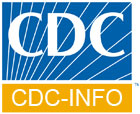Skip directly to the search box, site navigation, or content.
Division of Foodborne, Bacterial and Mycotic Diseases (DFBMD)
Campylobacter
Clinical Features
Diarrhea (often bloody), abdominal cramps, and fever. Illness typically lasts one week.
Etiologic Agent
Campylobacter, a gram-negative, microaerophilic bacterium. Most human illness is caused by one species, Campylobacter jejuni.
Incidence
Campylobacter is the most common bacterial cause of diarrheal illness. In 2006, the Foodborne Diseases Active Surveillance Network (FoodNet) estimated the incidence to be 13 cases per 100,000 population. An estimated 2.4 million persons are affected each year.
Sequelae
An estimated 124 fatal cases each year. Can cause life-threatening bloodstream infection in persons with compromised immune systems. Approximately 1 in 1000 diagnosed infections lead to Guillain-Barré syndrome, a paralysis that lasts several weeks and usually requires intensive care.
Transmission
Contaminated food (particularly poultry), water, or contact with infected animals (particularly cats and puppies).
Risk Groups
All age groups. Infants and young adults are particularly likely to be infected.
Surveillance
National surveillance is conducted through the Public Health Laboratory Information System (PHLIS). Active laboratory- and population-based surveillance is conducted in FoodNet sites. Surveillance for resistance to antimicrobial agents is conducted through the National Antimicrobial Resistance Monitoring System (NARMS).
Trends
Most cases are isolated, sporadic events, not part of outbreaks. The incidence of sporadic infections in FoodNet sites has decreased 30% since 1996-1998, reaching 13 per 100,000 persons in 2006. In 1995, fluoroquinolones were approved for use in poultry flocks to reduce respiratory infections due to crowding. Between 1997 and 2004, the percent of human Campylobacter isolates tested through NARMS that were resistant to ciprofloxacin increased from 12% to 19%. In 2005, FDA withdrew approval for these agents for use in poultry.
Challenges
Decreasing the contamination of poultry meat. Reducing the development of resistant strains. Preventing the sale of raw milk. Detecting outbreaks. Determining the proportion of cases related to poultry. Determining the proportion of infections due to consumption of well water. Consumer education. Identifying sources and syndromes associated with campylobacters other than C.jejuni.
Opportunities
Improving detection of dispersed outbreaks through molecular subtyping. Determining risk factors for sporadic illness, for Guillain-Barré syndrome, and for resistant infections.
Content Source: National Center for Zoonotic, Vector-Borne, and Enteric Diseases (ZVED)
Program Contents
Contact Information

